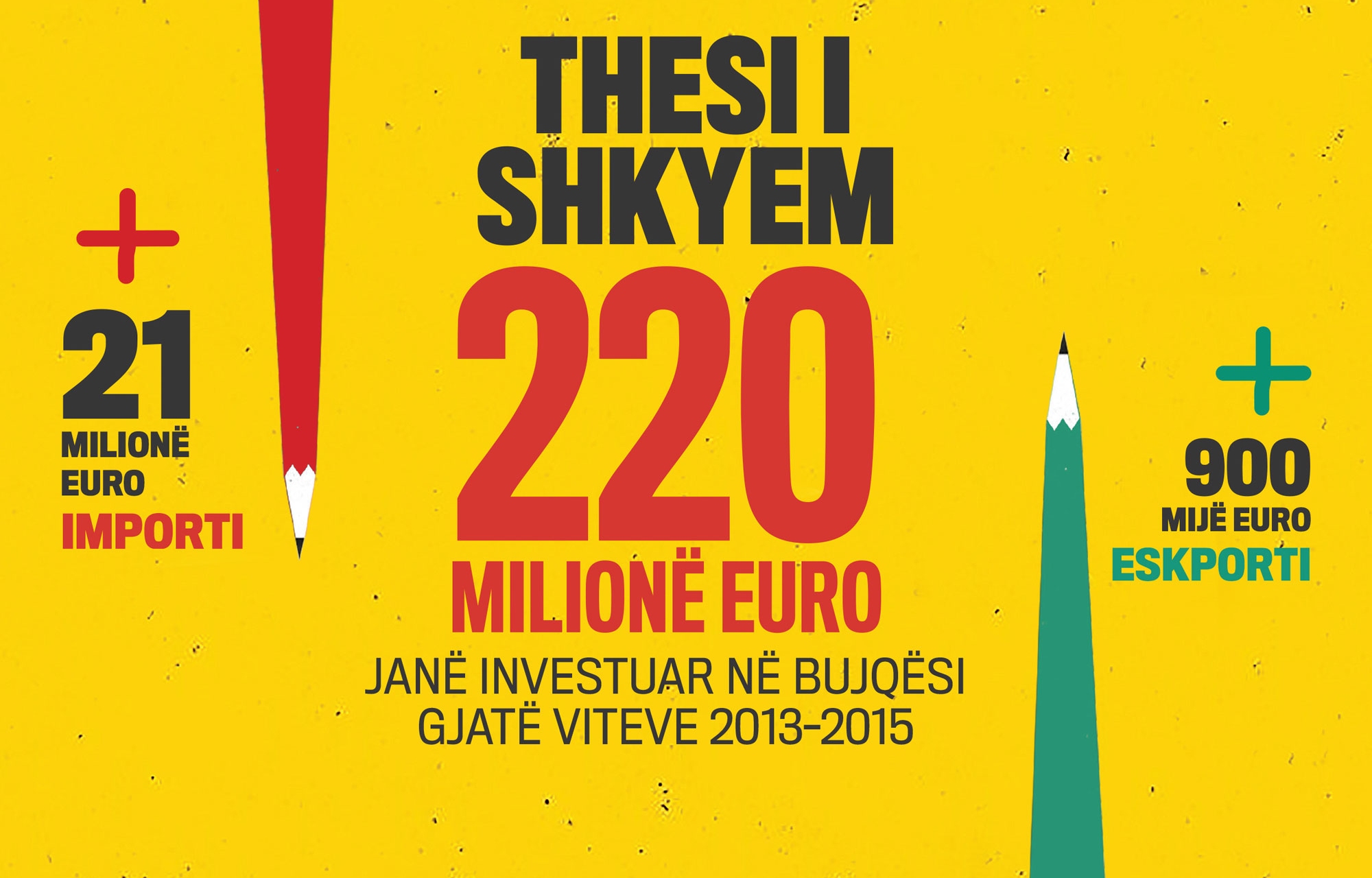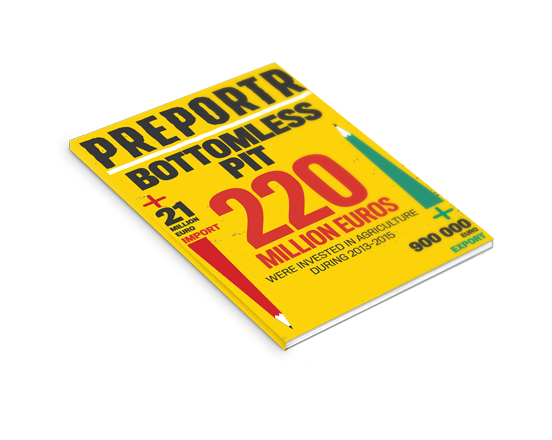Prishtinë, 16 December 2016
In recent years, millions of Euros were invested in the field of agriculture. Many cultural produce supported by the Government of Kosovo, respectively the Ministry of Agriculture, Forestry and Rural Development (MBPZHR), the basic consumption products, cannot be obtained from production. All those investments did not put an end to the trend of import. On the contrary, it featured constant growth. This growth of import was not the result of the growth of consumption, because there is no considerable growth for the said products. Also, it can be said that this investment did not cause a considerable growth of export. The gap between the export and import regarding these products continues to be quite big.
After conducting the first research related to the allocation of grants, preferential granting and injustices in this process, Preportr continued their work in order to look into economic aspects of the investments made in agriculture, namely to see the impact of these investments in relation to production, import, export, consumption and the influence of agriculture in economic development.
In order to see this impact, Preportr took into consideration a number of basic products that were subject of major investments such as milk, beef, wheat and vegetables. In other words, the subject of analysis were the investments made in greenhouses, investments in open-field vegetable production, investments in farms for dairy cattle, fattening of calves, and wheat subsidies. These are the fields where direct investments were made, subject to the research of Preportr, since there were also millions of euros invested in other fields which are linked indirectly to the said sector, such as the investments made in agricultural mechanisms, or processing machinery.
Around 230 million euros were invested in agriculture in the last three years, but these millions did not impact a considerable share of Agriculture in country's GDP. Despite the big investments in this fields in the last three years, this share did not grow, but rather oscillate throughout years. This is what the Kosovo Statistics Agency data show. According to these data, in 2013 the share of agriculture in GDP was 11.9%; in 2014 it was 11,8%, while in 2015 it was 11%.
The experts of agriculture say that the lack of effect of investments in this field on economy happens due to the lack of a prior analysis related to the sectors and the agricultural produce to be invested into. Another part of this failure, according to them, has to do with the poor management of subsidy and grant schemes. A professional monitoring in the field would display shortages in the process of investment and in the achievement of results.
The published reports and the mechanisms that are in place in MBPZHR, shot that there is no harmonization of data related to the investments made in agriculture, which further complicates the analysis of the situation and planning in line with the progress in place. The Ministry of Agriculture neither has the data related to the total amount of investments made in agriculture on country level, which also implies a lack of coordination among different institutions.
Investments in vegetables did not diminish the trend of import
Based on investments, the priority of MBPZHR seems to be the construction of greenhouses and the cultivation of vegetables in open field. Based on reports published by the mechanisms within the MBPZHR, during 2013-2015 an amount of 9,436,909 euros was invested in greenhouses in the form of grants, out of which 6,176,093 euros were allocated by the ministry while the farmers contributed with 3,260,817 euros. In open-field vegetable cultivation during 2013-2015 a total of 508,283 euros was invested, out of which the Ministry allocated 327,928 euros and the donors contribution was 180,355 euros. Apart from investments in the form of grants, during 2013-2015 the Ministry of Agriculture also gave subsidies (direct payments) for open-field vegetable cultivation. During this period, the Ministry allocated 2,496,222 euros in the form of subsidies.
Despite a considerable investment made in greenhouses and open-field vegetable production, the results are not satisfactory, because these investments did not lower the import, but rather increased it during 2013-2015 regarding produce such as tomatoes, cucumbers, peppers etc.
Tomatoes
In 2013 Kosovo imported around 13.7 million kg tomatoes in the amount of around 3,3 million euros. In the year that followed, the import was increased by 3 million kg in the amount of 5,2 million euros.
In 2015, compared to 2014, there was a decrease of import amounting 1,7 million kg, but the value of import in euros was also increased for 200 thousand euros.
During this period (2013-2015) the import of tomatoes increased for 10%, while the value of the import in euros was increased for 6%.
The export of tomatoes in this period was considerable lower than its import.
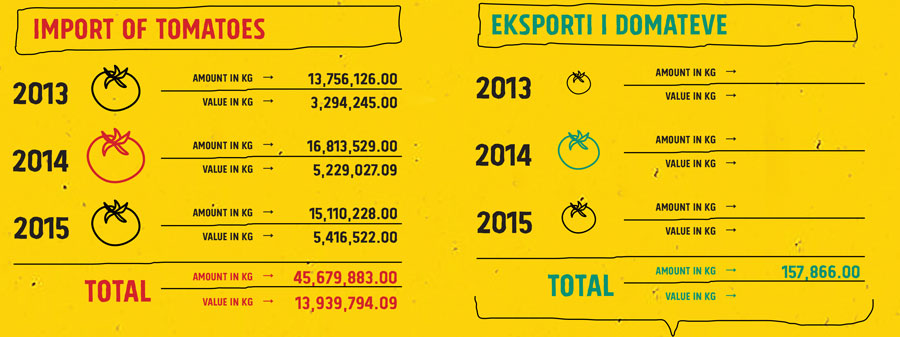
In 2013, Kosovo exported 32 thousand kg tomatoes in the amount of around 5 thousand euros. In 2014, the amount of export doubled, while the value in euro was increased for 20 thousand euros.
In 2015 there is a slight decrease of export both in terms of amount and its value in euro.
During this period (2013-2015) the export of tomatoes doubled, both in terms of the amount and in its value in euros.
Although the export doubled, there is still a huge difference with the import.

During these years, Kosovo imported 45 million kg tomatoes in the amount of 13,9 million euros, while it exported only 158 thousand kg tomatoes in the amount of around 40 thousand euros.
These statistical data show an increase of the export but at the same time an increase of the import as well for the same period, even though the figures do not imply any growth of consumption, including the fact that despite the investments made in these produce the import continues to provide for the major part of domestic market. The data of Kosovo Statistics Agency show that despite the investments made during the last three years in greenhouses and open-field vegetable production, that did not result with an increase in the production of tomatoes. According to the data of this agency, in 2013 Kosovo produced 17,291 tons of tomatoes, while in 2014 the production was almost at the same level with 17,386 tons of tomatoes.
Peppers
A very similar scheme between import and export applies also to peppers. Based on the data of Kosovo Customs, in 2013 Kosovo imported 9 million kg peppers, in the amount of 3,4 million euros.
In 2014, there was an increase of 14.63%, while the value of import in euros increased for 27%. In 2015, Kosovo imported 267 thousand kg less than in 2014, but in terms of the value in euros this is not applicable, because the value of import for 2015 was for 296 thousand euros higher than the last year.
Despite the investments, the import during this time increased for around 10% in amount and around 35% in its value in euros.
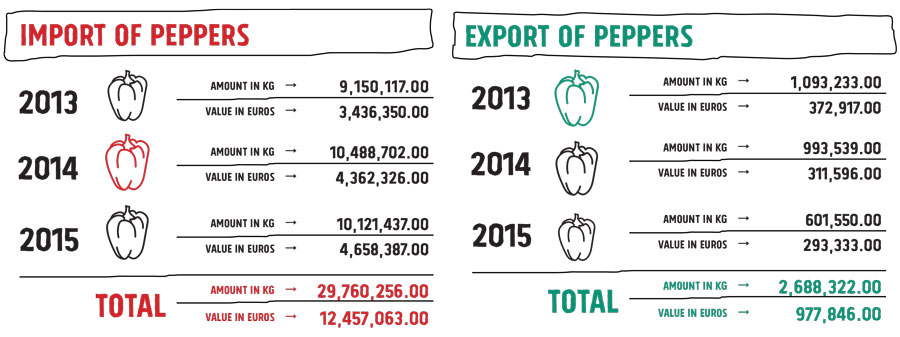
The export of peppers marked a diminishing trend during 2013-2015. In 2013, Kosovo exported 1 million kg peppers in the amount of 373 thousand euros. In 2014 this export decreased for 9%, and in 2015 there was a further decrease of 39.5% compared to 2014.
In the case of this produce too, the difference between export and import is quite big. During this three-year period, Kosovo imported 29.7 million kg peppers, in the amount of 12.5 million euros, while it exported only 17 million kg, in the amount of 977 thousand euros.
The investments of the Ministry of Agriculture had no desired effect also in the production of peppers. According to ASK data, in recent years there was a decline in the production of peppers. In 2013, Kosovo produced 72.928 tons of peppers. In 2014 there was a decline in production, with a 15 thousand kg less peppers compared to 2013.
Cucumbers
The import of cucumbers too did not change much, and the trend is almost the same, but there is an increase in its value in euros. In 2013 Kosovo imported 5.4 million kg cucumbers in the amount of 1 million euros. In 2014 there was a decline in import, with 30 thousand kg less import, but its value in euros was higher for 491 thousand euros. In 2015 Kosovo imported 321 thousand kg less cucumbers than in 2014, but in terms of the value in euros this is not the case, because the value of import for 2015 was for 300 thousand euros higher than the last year.
The export of cucumbers was very low. In 2013 Kosovo exported 6 thousand kg cucumbers in the amount of 645 euros. In 2014 the situation was similar, while in 2015 the export increased considerably, with over 109 thousand kg in the amount of 42 thousand euros.
If we compare the export and the import, we will see that during 2013-2015 Kosovo imported 15.8 million kg of cucumbers in the amount of 4.4 million euros, while it exported only 122,532 kg in the amount of around 44 thousand euros.
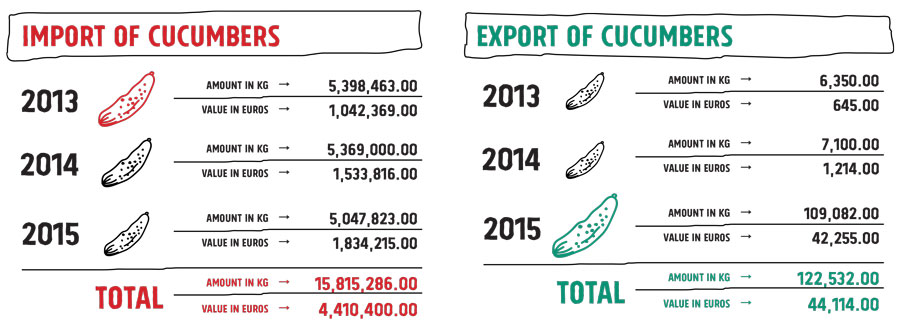
Therefore, despite the millions of euros invested in vegetables, there was a continuous growth of import, and on the other hand, according to the Green Report of the Ministry of Agriculture, there was no considerable growth of consumption. If we only take peppers and tomatoes, we see that in 2013 the consumption was 77.974 tons of peppers, while in 2014 there was a slight decrease of consumption, with 65.99 tons of peppers consumed. On the other hand, there was a slight growth of consumption of tomatoes in 2014, with 33,4 tons consumed, while in 2013 this consumption reached 30,324 tons of tomatoes.
The millions of euros invested in the fattening of calves did not put an end to the trend of import of beef
The Ministry of Agriculture invested in project for the fattening of calves, but despite the millions of euros of investments, the import was not reduced at all during the last three years. In 2013, 596,526 euros were invested for the fattening of calves. In 2014 and 2015, 6,5 million euros were invested for the fattening of calves and for meat processing. euro.
Despite all these investments, during 2013-2015 there was a trend of the growth of import of meat. In 2013, Kosovo imported 6.4 million kg beef with an amount of 16 million euros, while in 2014 the import was 9 million kg or 21. million euros. Compared to 2013, there was a growth in import in the amount of 2.8 million kg, while the value of the import was 5.3 million euros. . In 2015, the import of meat reached 8,1 million kg, or 21.5 million euros. euro. So, the import dropped for 1.1 million kg, but not in terms of the value in euro, because compared to 2014, the value of import was higher for 142,654 euros.
From 2013 to 2015, the imported amount grew for 26%, while the value of import grew for 34.5%.
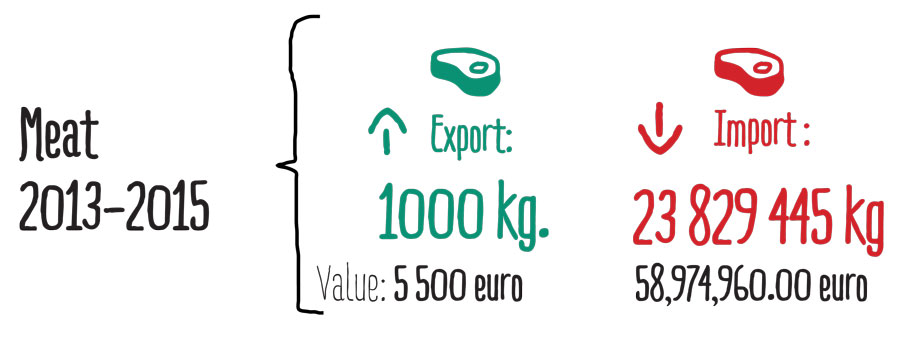
The export figures also show that the investments towards meeting the demand for meat did not reach the desired effect. Kosovo in 2013 and 2015 did not import a single kilo of meat, while in 2015 it exported only 1000 kg, in the amount of 5,500 euros.
So, Kosovo is far from meeting the demands of its citizens for meat. Recently, thanks to investments, the production in the country is growing, but so is the import, and this growth of the import was not a result of growth of consumption, since the reports of the Ministry of Agriculture show that the consumption of meat did not oscillate much throughout years. In 2011, this consumption was 22.7 kg per capita during a year; in 2012 it was 20.4 kg per capita; in 2013 the consumption was almost the same, and that 21 kg per capita; in 2014 the consumption was 18.4 kg per capita.
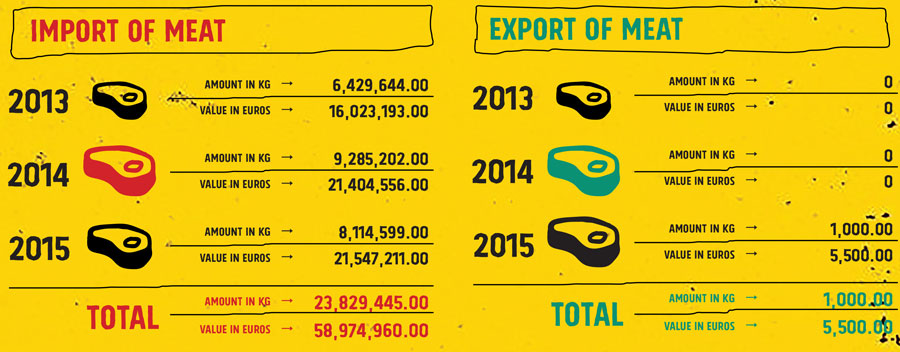
If we compare the import and the export of meat during 2013-2015, we will see that during this period Kosovo imported 23.8 million kg meat, reaching the amount of 58.9 million euros. euro. The export during this period was very low, since only 1 thousand kg of meat were exported during 2013-2015.
Tens of millions of euros for wheat are far from meeting the citizens' demands
During 2013-2015, Kosovo invested 17 million euros for wheat in the form of subsidies. In 2013, Kosovo invested 5.8 million euros; 5.5 million euros were invested in 2014, while in 2015 the investment was higher for 1 million euros, respectively 6,412.884 euros.
In 2013, there was no export of wheat. In the coming years, the export was very low, despite an increase in 2015. In 2015, the export of wheat grew for 203 thousand kg in the amount of 57,855 euros.
When it comes to import, the situation is different. In 2013, Kosovo imported 53.5 million kg wheat in the amount of 11.8 million euros. In 2014, there was a 13.8% reduction. In 2015 the import grew and reached 61.6 million kg, in the amount of 12.7 million euros.
Between 2013 and 2015 the amount of imported wheat grew for 15%, and during this time the expenses for the import of wheat grew for 7.6%.
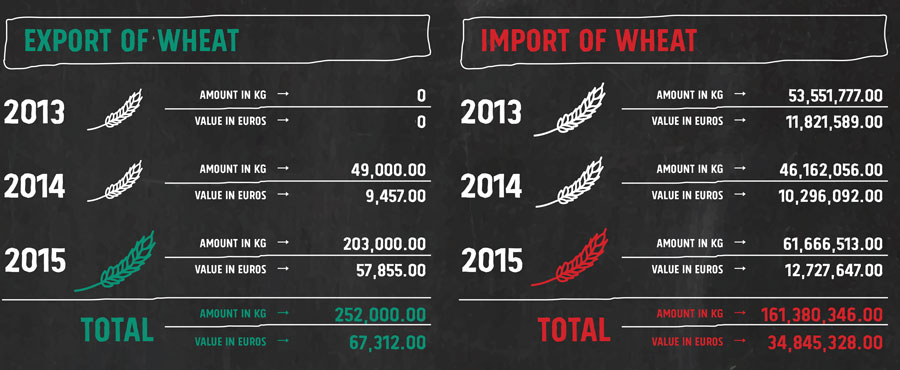
The difference between the import and the export of this product during 2013-2015 is very high. Only 252 thousand kg were exported in the amount of 67 thousand euros. On the other hand, the import reached 161.3 million kg, in the amount of 34.8 million euros.
According to ASK data, there was no growth in the production of wheat either. In 2013 Kosovo produced 391.727 tons of wheat, while in 2014 there was a slight decline in production, with 331,296 tons of wheat.
Flour
Beside wheat, in order to meet citizens' demands Kosovo imported a considerable amount of flour, marking a growth throughout years. In 2013 Kosovo imported 45 million kg flour, in the amount of 11.6 million euros. In 2014, the import of this product grew for 8.8 million kg. In 2015, the import grew again for 1.6 million kg.

The export of flour, as is the case with other products, is quite low. In 2013, Kosovo exported 1.7 million kg flour in the amount of 474 thousand euros. In 2014, the export reached 966 thousand kg flour, in the amount of 247 thousand euros. In 2015, Kosovo exported around 1 million kg of flour, in the amount of around 270 thousand euros.
Milk
A lot of investment was also made in this product. Despite these investments, the import of milk grew continuously from year to year. According to our data obtained from the lists of beneficiaries published by the Ministry of Agriculture, during 2013-2015, in the form of grants and subsidies 15,870,926 euros were invested for milk. In 2013, the Ministry of Agriculture invested somewhat more than 1 million euros for dairy cow farms in the form of grants. In 2014 this investment was 1,6 million euros, while in 2015 it reached 5 million euros, in the form of grants.
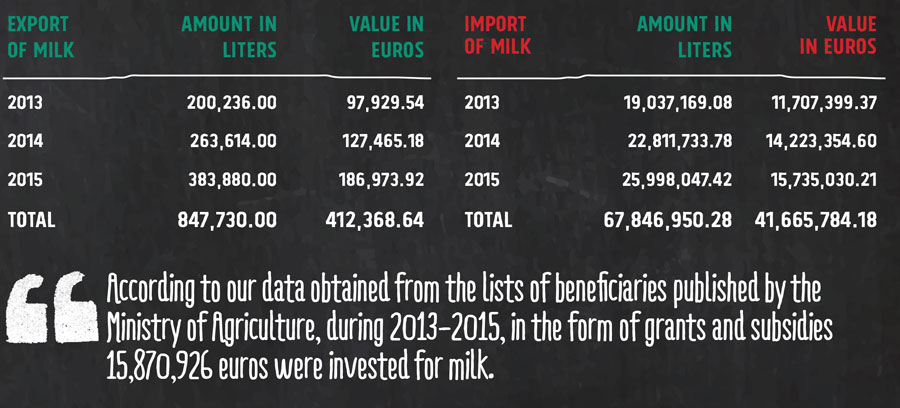
There is no accurate data regarding the funds spent as subsidies for dairy cows, since the Ministry in this category included both dairy cows and buffaloes. In 2015 3 million euros were spent for dairy cows and buffaloes. 2 million euros were spent in 2014. Direct payments for milk were made also for categories ranked by quality. 2 million euros were spent in 2014 and 2015, and that, 1,5 million euros per year.
The big investment during these three years did not have a considerable impact on the export of milk. In 2013, Kosovo exported 200,236 liters of milk in the amount of 98 thousand euros. In 2014 exports increased slightly to 263,614 liters in the amount of 127 thousand euros. While in 2015, 383,880 liters were exported in the amount of 187 thousand euros.
The import of milk was not reduced. On the contrary, from 2013 to 2014 it grew in the amount of around 3 million euros. In 2013 Kosovo imported 19 million liters of milk in the amount of 11,7 million euros.
In 2014 the value of imports of milk reached 14.2 million euros with 22,8 million liters of imported milk. In 2015, Kosovo imported 25,9 million liters of milk in the amount of 15,7 million euros.
The difference between export and import during the last three years was very high. During this period, Kosovo imported 67,8 million liters of milk in the amount of 41,6 million euros. The export was very low. During this period, Kosovo exported 847,730 liters of milk in the amount of 412,368 euros.
Taking into account the trend of import of this product, it is interesting to note that the consumption from 2013 to 2015 dropped considerably. In 2013, Kosovo consumed 341.75 tons of milk, while in 2014, the consumption was 273.146 tons of milk.
The Ministry of Agriculture does not have data on the amount of investments made throughout years
Apart from the investments made by the Government of Kosovo, municipalities too invested in the field of agriculture. Preportr contacted all municipalities of Kosovo to obtain data on the investments made in recent years in the field of agriculture, but unfortunately most of them do not have the data for previous years. Also most of the municipalities do not have data regarding the amounts they have benefited from foreign donations. The data we managed to obtain show that the municipalities of Kosovo during 2013-2015 invested at least 15 million euros in the field of agriculture. This amount could be even higher, but not all municipalities had data on the investments made in this period, since according to them, the past municipal governments did not archive these data.
Among the municipalities that invested the most in the field of agriculture in this period are: Prishtina, (2,696,970.00 euros), followed by Peja (1,590,404.60 euros), Rahovec (1,289,510.00 euros), Prizren (1,222,139.00 euros), Fushë Kosova (1,126,019.00) and so on. The municipalities that invested the least are: Dragash (5,000.00 euros), Deçan (16,980.00 euros), Hani i Elezit (21,759.00 euros), Lipjan (52,400.00 euros) and so on.

Neither the Ministry of Agriculture does have an integrated database of financial assets given to agriculture. There are no data on the amounts invested by municipalities, and no data on the amounts invested by different donors. The lack of such a database is an obstacle to analyse the impact of investments in agriculture and in various agricultural cultures. In Kosovo, there is no clear information on the amount of financial assets invested throughout years. On the other hand, the municipalities do not have data regarding the farmers from those respective municipalities who got grants from the ministry. In other words, there is a lack of coordination between municipalities and the Ministry of Agriculture in this aspect.
Regarding the lack of information and databases of the Ministry of Agriculture, Ibrahim Rexhepi, director of the Center for Strategic and Social Research "STRAS" says that if the ministry does not have basic data on the potentials and the current situation in agriculture, then in this case we are talking more about a boast regarding the invested amounts than about the effect those investments produce in agriculture.
"Considering that the Ministry of Agriculture does not have data on the funds invested by the municipalities, data on crops and donor investments across different projects, then the question is: what is the use of such a ministry?! I understand the financial independence of municipalities and donors, but there must be a coordinator or at least information on what is invested, because the ministry is responsible for the creation of policies which build concepts and strategies, and not donors and municipalities on their own. We are not saying it should dictate, but rather, by using information, create channels where the funds would go in order to have a greater effect", said Rexhepi.

In addition to the lack of a comprehensive database on the investments made in agriculture in Kosovo, the Ministry of Agriculture has published reports about the investments that have been made, but those projects are reported with different figures, although their publishers are mechanisms that operate within the ministry.
From the table we see that the planned results are achieved and exceeded in the fruit sector, but the report is vague and questions the quality of data, because the Business Development Agency in its annual report shows the number of approved projects and the number of implemented projects is not clear; the Monitoring Division reported approved projects rather than the number of implemented projects. The Green Report within the ministry has reported on the results at the country level. But the Department of Statistics in the Ministry has not made clear the result of support through grants (Kosovo budget) and other funding sources that influence the development of the agricultural sector in the country.
The auditor's report states that this form of reporting to the Ministry does not reflect accurately the results achieved, and creates confusion regarding the real situation. This further complicates the measuring of progress, the identification of shortages and the drawing of lessons for the future when it comes to grants.
"Two different figures on the number of supported farms were presented within the Program; in the beginning there were 20 farms in the dairy sector, and then this number on the table of individual support was 30. Another discrepancy was noticed in the Administrative Instruction drafted for the purpose of the implementation of the Program. This document sets out the support for 38 farms in this sector. The difference between the set indicators on the number of farms may cause confusion and difficulty in measuring the results/effects of the annual Program, since the objective is not clear" says the report of grants audit, published in 2015.
Failure in the management of grants and subsidies
Alban Hashani professor of economics, told Preportr that the main primary is the way the subsidies and grants scheme is managed. He says it is not clear how we came up to this formula, it is not clear why those subsidy quotas were set for different crops; in other words, the methodology used to get these quotas and for them to remain unchanged is not clear.
"When we consider that the whole purpose of investing in agriculture is the opening of jobs since unemployment has been identified as the primary economic problem, or that this result is not achieved through agriculture, then let's not give subsidies, but, say, let's give IT subsidies, because perhaps the profit is there. So, if this was our principal goal, then we should analyze whether we are producing the desired effects" says Hashani. He says we must go back to the basic questions related to the results produced by subsidies and grants, and not just invest and then see how it goes without proper monitoring. He believes that we should make sure that from the moment a farmer gets one part of the subsidy, he should get the second part when the product is launched and link it to the result of the work. This, according to him, would maximize the result that a subsidy could produce.
Given that some projects have failed, and many stalls as well as greenhouses were closed down, Hashani considers that the monitoring capacities should increase within the ministry, because the current ones monitor many projects and it is very likely for them to be corrupt.
According to him, should the number of the inspectors increase and randomly determine projects to be monitored by them, then they would not know were they go, and it would be easier to carry out the monitoring and the competitiveness between them would be more emphasized.
Hashani says that work should be done in order to secure the internal market and not to allow monopolization, since in such cases farmers are seriously damaged and that may even lead to bankruptcy, adding that the functioning of the Competitiveness Commission is indispensable to fix these things in the market.
"For example, we have an increase of hectares of planted raspberries, but there are collectors who are quite strong and who, due to lack of functioning of the Competitiveness Commission, could abuse its position in the market, and by doing that they take all the surplus of the producers from the respective farmers," said Hashani.
Ibrahim Rexhepi, director of STRAS says that the key problem is the lack of a long-term concept of the Government for the development of agriculture. According to him, all public investments that have been carried out so far are more of an "ad hoc: character then a clear concept on why an investment is made, where it is made, and what the final effect should be.
"The reasons for this failure have to do with a vision of both this and all other previous governments, which is the funding of import from the state budget, and while there is such an approach all the talking about domestic development is in vain - and that approach is that with a 2-3% growth we could have a sustainable development and that the agriculture would have an important role in the overall welfare of the citizens," says Rexhepi.
He says that in every election campaign, Thaçi promised subsidies, from 100 to 1000 euros for every kind of product. Rexhepi thinks that because of Thaçi's political power, all these promises were foreseen in state budget, and not because he had a back-up analysis, an accurate assessment that those products really deserve to be financed, but rather because he wanted to satisfy his electorate.
"There is no analysis on how these investments were reflected. Why, at least, they did not cause any reduction in import. So, there was no monitoring due to abuses, due to corruption and mismanagement of public money. There is no responsibility and accountability, there is no adequate monitoring and identification of problems, and the worst of all is that all links of this state chain are interconnected," added Rexhepi.
The Ministry of Agriculture will not change the fields of investments
Shqipe Dema, director of the Department of Rural Development Policy, told Preportr that the assessment of the impact of investments in the Agriculture and Rural Development Program is carried out with monitoring and evaluation indicators, and that the import-export concept cannot be an indicator of success or failure of investments in the agriculture sector.
"Customs data may show growth of import, but as an isolated figure it does not provide information on the increase of domestic production. In other words, first we should measure the GDP, and then compare it to other data that show to what and which elements should this growth of import be attributed. After that, we should carry out an analysis of import and export of processed products, consumption etc., in order to reach such a conclusion. But, in recent years there is a growth of export of agriculture products: 12% in 2014 compared to 2013, and 5,7% in 2015 compared to 2014," says Dema.
On the other hand, according to ASK data, the influence of agriculture sector in GDP did not grow, rather there was a slight reduction in the past three years. In 2013, the participation of agriculture in the GDP was 11.9%; in 2014 it was 11.8%; in 2015 it was 11%. So, this parameter too shows that the investments in agriculture did not have a desired effect so far.
Shqipe Dema says that lots of investments in agriculture have at least a three-year effect after they have been carried out. She says that the investments in food safety and standards have a direct impact on agricultural production, while the investments in pomiculture have impact sometimes after three years.
When asked about the methodology, studies or analysis used to determine or select measures used by the Ministry of Agriculture, Dema said that the Agriculture and Rural Development Program is designed according to rules and procedures of IPARD (IPA Rural Development) which aims to support candidate and pre-candidate countries of the EU restructure and develop the agricultural and rural sector - food industry - in order to be competitive with the EU countries. She says that the selection of measures is carried out through SWAT analysis.
Despite the results achieved so far, she says that these measures will not change and both expertise and professional analysis are needed in order to change policies (ex-post and sectoral analysis) which should orient us and provide recommendations in this direction.
"Contrary to this, those two reports recommend growth of investments in these measures," says Dema.
She says that during the last three years, as a result of investments in agriculture through grants, the number of the employees in this sector grew as well. In 2013, as many as 997 new jobs were created; 1,156 new jobs were created in 2014, while in 2015 as many as 1,502 new jobs were created.
Meanwhile, the Labor Force Survey data obtained from the ASK show a trend of reduction of the number of employees in the agriculture sector in the last three years.
According to these data, 82,898 citizens were surveyed and only 18,577 were employed i the agricultural sector, or 5.4%. 87,617 citizens were surveyed in 2014, and only 7,372 work in the field of agriculture, or 2,3%. 84,217 citizens were surveyed in 2015, and this sample shows that 5,451 worked in the field of agriculture, or 1,8%.
According to Eurostat's recommendations, the employed persons are those who work in agriculture and whose final product is launched in the market, as well as those people who work in agriculture and whose product makes for an important contribution to the total consumption of households.
Two favored municipalities
According to the data of the Ministry of Agriculture, the grants were not distributed fairly among all municipalities. Out of smaller municipalities, Skenderaj (98 grants) and Drenas (56 grants) got most grants, as compared to other smaller municipalities, with a bigger potential for the development of agriculture. Moreover, these two municipalities benefited more than other bigger municipalities, such as Mitrovica (57 grants), Peja (45), Gjakova (42), Gjilan (35) and so on.
If we consider the financial value of these grants, Skenderaj and Drenas again result to be the most favored municipalities. During 2013-2015 period, the Ministry of Agriculture allocated grants in the amount of 5,336,842 euros for Skenderaj, which ranks it on the third place of the most supported municipalities, since the first one is Prishtina with 7,978,739 euros, and the second one is Prizren with 6,163,371 euros. The amount of support in Drenas during this period was 3,289,985 euros. Hence, this municipality benefited more than Podujeva, Gjilan, Peja, Mitrovica, etc.
The Ministry of Agriculture did not "forget" the political party donors
Besides getting millions of euros’ worth of public bids, some of the donors of political parties also got grants from the Ministry of Agriculture, the amounts of which are quite high, and there are also cases of those who got two grants within two years.
The list of grants given during 2013-2015 period includes also donors of PDK and VV. Preportr found 13 beneficiaries of grants, who in turn gave donations for those two political subjects, the former being part of central government, while the latter is in opposition.
Rrustem Rrukolli from Skenderaj, owner of N.N."R&Rukolli" sh.p.k as natural person in 2009 gave 5,000 euros for PDK (five times 1,000 euros, at different times). In 2014 and 2015 he got two grants from the Ministry of Agriculture for milk processing in the amount of 800,000 euros. The owner of this company is known for having strong ties with PDK, and being a frequent winner of tenders. Only between August 2007 and May 2014, this company won 12 tenders from public institutions in the amount of 21,843,595 euros.
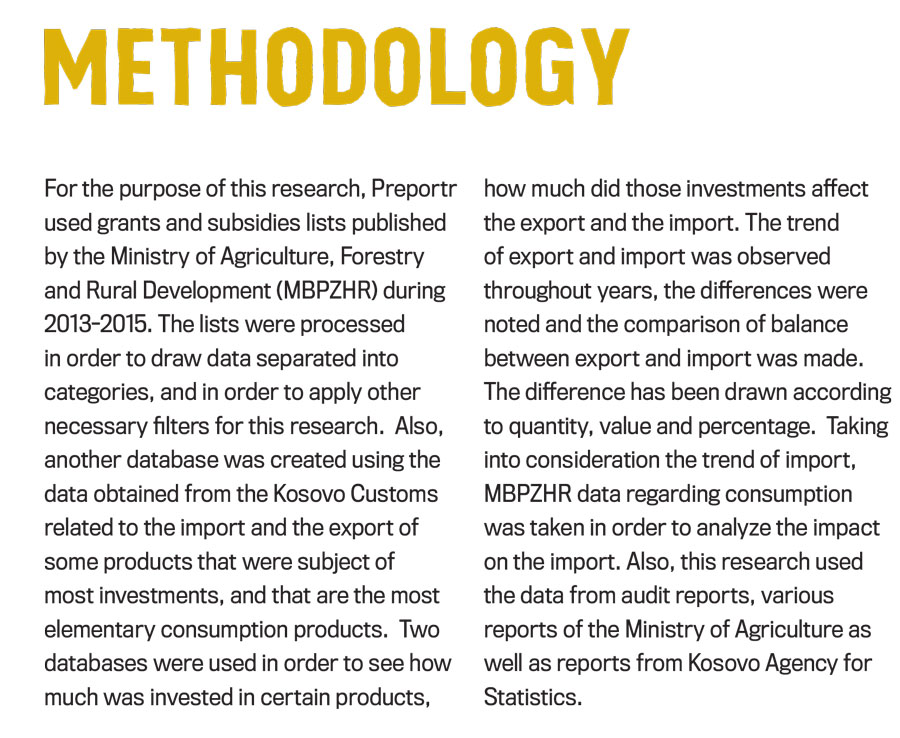
Xhelal Selimi from Gjilan, owner of “Calabria” sh.p.k, as natural person gave 12 donations in 2014 and 1 donation in 2011, in both cases to PDK, with a total amount of 3,490 euros. In 2015, he got a grant for meat processing in the amount of 395,000 euros. He is also the owner of two companies, “Euro Plast” and “Grande Calabria.”
“Ben Af” company from Suhareka during 2010-2012 gave 4,400 euros to PDK, and 240 euros to VV. In 2013, this company got a grant in the amount of 257,327 euros. Between August 2007 and May 2014, this company won 8 tenders in the amount of 548,829 euros.
N.T.P. "Malësia" in the ownership of Demush Spahija from Gjilan, in 2012 donated 500 euros to PDK. In 2014 this company got a grant for milk processing in the amount of 328,091 euros. This business has been closed down, while its owner has another company called "Malësia" sh.p.k. and is the co-owner of another company with the same name.
N.N.P “Mati – Com” in the ownership of Brahim Kryeziu from Malisheva in 2010 donated 1,000 to PDK, while in 2013 he got a grant related to the processing and the marketing of agricultural products in the amount of 240,552 euros. Between August 2007 and May 2014 this company won a tender in the amount of 284,253 euros.
Ismet Neziraj from Deçan in 2010 donated 500 euros to PDK as natural person. He is the authorized person of N.P.SH.''Bleta'' in the ownership of Gjylsime Neziraj. This company in 2013 got a grant for beekeeping in the amount of 15,000 euros. N.P.SH. ''Bleta'' was closed down in 2014. Ismet Neziraj, on the other hand, is the director of Regional Water Supply Radoniqi-Dukagjini, and was the candidate of PDK for municipal assembly of Deçan during 2007 local elections.
Tahir Thaçi from the municipality of Rahovec in 2012 donated 120 euro to PDK as natural person. In 2013, he got a grant in the form of physical assets for wheat in the amount of 56,462 euros. He is the owner of “Elita” company and the co-owner of N.T.SH. "Cani 3."
Sh.p.k “Rugove” got three grants for milk processing, one in 2013, one in 2014, and one in 2015. The total amount of grants is 839,131 euros. The owners of this company are Visar Kelmendi and Vllaznim Xhiha. They are also the owners of "Ujë Rugove" on behalf of which they gave a donation in the amount of 300 euros for VV.
ABI Sh.p.k - Alejdin Fusha in 2013 and 2015 got two grants in the amount of 651,770 euros. He is the authorized person of Newco Gamma L.L.C, whose owner is P.T.T. “Abi”. On behalf of “Abi Center” 50 euro were donated to VV in 2012. This donation was given in the name of "Abi Center", while the declared fiscal number in the list of donations is 600620521 which, according to TAK, is linked to “Abi” SH.P.K, registered in Prizren.
Muhamet Fazliu from Rahovec in 2012 donated 1,000 euros to PDK. In 2013, he got a grant for open-field vegetable production in the amount of 525 euros.
N.P.N. "Mega" Sh.p.k in the ownership of Florina Zymberi and Mejdi Zymberi from Gjilan in 2013 got a grant for the watering of arable land in the amount of 16,000 euros. Florina Zymberi in 2012 donated 10 euros for PDK.
Moea Sh.p.k got two grants in 2013 and 2014 in the amount of 280,058 euros. One grant was for the watering of arable land, while the other one was for physical assets and the trading of agricultural products. In 2011, this company donated 300 euros for VV.
I Seferi sh.p.k in the ownership of Haxhi Seferaj from Suhareka, in 2011 and 2012 donated a total of 150 euros to VV. In 2015 the company got a grant for fruit and vegetable processing in the amount of 400,000 euros. Between August 2007 and May 2014 this company won three tenders in the amount of 4,862,610 euros.

